

Department of Interior Adds 18 Historic Landmarks
Interior Secretary Gale A. Norton designated 18 properties as National Historic Landmarks—spanning the gamut from two Frank Lloyd Wright houses to Elvis’ Memphis recording studio—at a Washington, D.C., ceremony July 31. Wright’s contributions to the list include his 1936 Herbert and Katherine Jacobs First House, Madison, the first house to reflect his ideas of “Usonian” architecture, and the Herbert and Katherine Jacobs Second House, Middleton, Wis., his only solar house.
The National Historic Landmark designation is an official recognition by the federal government of an historic property’s national significance. Today, fewer than 2,500 historic places bear this distinction. The National Park Service nominates new landmarks and provides assistance to existing landmarks through its National Historic Landmark Program. The full list comprises:
 Herbert
and Katherine Jacobs First House, Madison. Designed by Wright and
built in 1936, the Jacobs House was the first among many Usonian houses.
This was the term Wright assigned to “an artistic house of low cost
for an average citizen of the United States of America.” The design
marked a turning point in the evolution of Wright’s residential
work. Picture courtesy of the homeowner.
Herbert
and Katherine Jacobs First House, Madison. Designed by Wright and
built in 1936, the Jacobs House was the first among many Usonian houses.
This was the term Wright assigned to “an artistic house of low cost
for an average citizen of the United States of America.” The design
marked a turning point in the evolution of Wright’s residential
work. Picture courtesy of the homeowner.
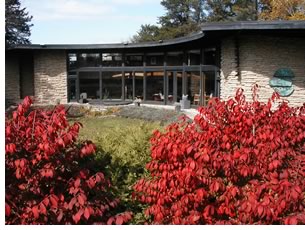 Herbert
and Katherine Jacobs Second House, Middleton, Wis. Named the “Solar
Hemicycle” and built 1946–48, this is the only solar house
Wright designed. The architect used circular rooms, southern glass walls,
and a berm to the north side to save energy. Developed three decades before
the energy crisis of the 1970s, the house served as an instructive attempt
to develop “low-energy” architecture. Picture courtesy of
the homeowner.
Herbert
and Katherine Jacobs Second House, Middleton, Wis. Named the “Solar
Hemicycle” and built 1946–48, this is the only solar house
Wright designed. The architect used circular rooms, southern glass walls,
and a berm to the north side to save energy. Developed three decades before
the energy crisis of the 1970s, the house served as an instructive attempt
to develop “low-energy” architecture. Picture courtesy of
the homeowner.
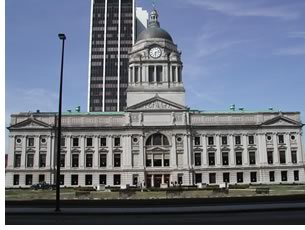 Allen
County Courthouse, Fort Wayne, Ind. Completed in 1902, the Allen
County Courthouse embodies the Beaux Arts architecture popular in the
U.S. at the turn of the 20th century. The building stands as a monument
to the civic pride and progressivism of early 20th-century America, and
represents a rare example of the combination of classical architecture,
fine art, and sculpture in an American county courthouse. Picture courtesy
of the Fort Wayne/Allen County Convention & Visitors Bureau.
Allen
County Courthouse, Fort Wayne, Ind. Completed in 1902, the Allen
County Courthouse embodies the Beaux Arts architecture popular in the
U.S. at the turn of the 20th century. The building stands as a monument
to the civic pride and progressivism of early 20th-century America, and
represents a rare example of the combination of classical architecture,
fine art, and sculpture in an American county courthouse. Picture courtesy
of the Fort Wayne/Allen County Convention & Visitors Bureau.
Jackson Lake Lodge, Moran, Wyo. Completed in 1955 and designed by Gilbert Stanley Underwood, perhaps the most prominent and influential architect in the history of the National Park Service, the lodge became the design precursor for the Mission 66 program of visitor center construction that transformed the National Park Service in the postwar years. It was also an influential example of the Modern architecture within the National Parks.
Dr. Oliver Bronson House and Estate, Hudson, N.Y. Associated with the early development of the Picturesque movement in America, this house was designed by architect Alexander Jackson Davis and then modified to his specifications in 1839. The Bronson House serves as the earliest surviving example of the architect’s work in the “Bracketed” style.
Prestwould, Clarksville, Va. Constructed in 1782, Prestwould is the most intact, best-documented, late-18th century plantation complex surviving in Virginia. It has earned particular attention for its diverse outbuildings, which formed a common way of living on Southern plantations.
 Buckingham
Friends Meeting House, Buckingham Township, Pa. Built in 1768,
Buckingham was the first meetinghouse erected in the symmetrically balanced,
two-celled or “doubled” form that separated the genders during
Quaker meetings. By the early 19th century, the Buckingham form clearly
established the model for Friends’ meetinghouse design throughout
the mid-Atlantic region. (National Park Service)
Buckingham
Friends Meeting House, Buckingham Township, Pa. Built in 1768,
Buckingham was the first meetinghouse erected in the symmetrically balanced,
two-celled or “doubled” form that separated the genders during
Quaker meetings. By the early 19th century, the Buckingham form clearly
established the model for Friends’ meetinghouse design throughout
the mid-Atlantic region. (National Park Service)
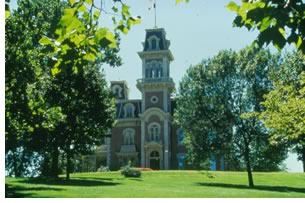 Terrace
Hill, Des Moines. Constructed in 1866, Terrace Hill represents
a pure, minimally altered Second-Empire house at the height of the style
in the U.S. It is considered the residential model of this ornate, grand-scale
style. Since 1976, it has served as the residence for Iowa’s governor.
Courtesy of the Iowa Department of Economic Development, Iowa Tourism
Office.
Terrace
Hill, Des Moines. Constructed in 1866, Terrace Hill represents
a pure, minimally altered Second-Empire house at the height of the style
in the U.S. It is considered the residential model of this ornate, grand-scale
style. Since 1976, it has served as the residence for Iowa’s governor.
Courtesy of the Iowa Department of Economic Development, Iowa Tourism
Office.
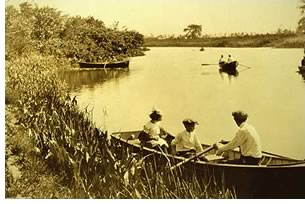 Columbus
Park, Chicago. Built 1912–1920, Columbus Park earned a reputation
as the masterwork of landscape architect and conservationist Jens Jensen.
Known as the creator of Prairie Style landscape design, Jensen also gained
renown as both the founder of the Midwestern conservation movement and
one of the most significant figures in American landscape architecture.
This park gave Jensen the opportunity to share with city dwellers the
benefits of communing with nature. (National Park Service)
Columbus
Park, Chicago. Built 1912–1920, Columbus Park earned a reputation
as the masterwork of landscape architect and conservationist Jens Jensen.
Known as the creator of Prairie Style landscape design, Jensen also gained
renown as both the founder of the Midwestern conservation movement and
one of the most significant figures in American landscape architecture.
This park gave Jensen the opportunity to share with city dwellers the
benefits of communing with nature. (National Park Service)
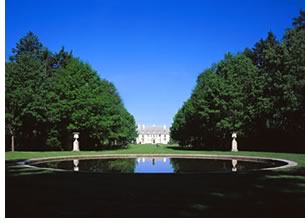 Oldfields,
Indianapolis. Designed by the Olmsted brothers, this estate house
and its surround typify the “Country Place” era of 1885–1939
of second homes constructed by American businessmen and industrialists.
The house belonged to the influential Lilly family; Josiah Kirby Lilly
Jr., the second owner, was perhaps the most famous for his business, philanthropic,
and humanitarian accomplishments. Oldfields — Lilly House &
Gardens, view from the allee, courtesy of the Indianapolis Museum of Art.
Oldfields,
Indianapolis. Designed by the Olmsted brothers, this estate house
and its surround typify the “Country Place” era of 1885–1939
of second homes constructed by American businessmen and industrialists.
The house belonged to the influential Lilly family; Josiah Kirby Lilly
Jr., the second owner, was perhaps the most famous for his business, philanthropic,
and humanitarian accomplishments. Oldfields — Lilly House &
Gardens, view from the allee, courtesy of the Indianapolis Museum of Art.
Ten Chimneys, Genesee, Wis. Ten Chimneys is associated with one of the first families of the American theater, Alfred Lunt and Lynn Fontanne. Throughout their careers, this house served as a creative hearth and quiet refuge from the Big Apple’s bright lights for the couple and their friends, including Noel Coward, Helen Hayes, Laurence Olivier, and Vivien Leigh.
Rebecca T. Ruark, Tilghman Island, Md. The Rebecca T. Ruark bears the distinction of being the oldest vessel in the skipjack oyster dredging fleet, the last commercial fishing sailing fleet in North America. Of the estimated 2,000 skipjacks built on the Chesapeake Bay before World War II, only about 16 survive.
 USS
Lexington, Corpus Christi, Tex. The aircraft carrier Lexington,
one of four (out of 20) World War II Essex-class carriers still surviving,
participated in almost every major naval campaign in the Pacific from
1943–45. She also illustrates development of carrier design and
integration of aviation as a primary strike weapon in naval strategy.
Of the four surviving carriers, Lexington had the longest service record,
from 1943–91. Courtesy USS Lexington.
USS
Lexington, Corpus Christi, Tex. The aircraft carrier Lexington,
one of four (out of 20) World War II Essex-class carriers still surviving,
participated in almost every major naval campaign in the Pacific from
1943–45. She also illustrates development of carrier design and
integration of aviation as a primary strike weapon in naval strategy.
Of the four surviving carriers, Lexington had the longest service record,
from 1943–91. Courtesy USS Lexington.
Centennial Baptist Church, Helena, Ark. Reverend (Dr.) Elias Camp Morris used Centennial Baptist Church as home base from its dedication in 1905 until Morris’ death in 1922. While pastor, Morris also served as president (1895–1922) of the National Baptist Convention (NBC), the largest African-American organization in the U. S. at the end of the 19th century, through which he focused attention on the right of African-Americans to establish independent religious associations.
Fort Yellowstone, Mammoth Hot Springs and Norris, Wyo.; Freemont County, Idaho.; and Gardiner, Mont. Fort Yellowstone, headquarters of the U.S. Army during its administration of Yellowstone National Park from 1886–1918, was the military’s longest and most extensive presence in the national parks. Principles and policies the administrators developed at this time shaped emerging conservation and U.S. national park movements.
The Baltimore and Ohio Railroad Martinsburg Shops, Martinsburg, W.Va. The shops offer a clear example of innovative 19th-century engineering and industrial architecture: An early cast-iron framing system devised by renowned railroad engineer Albert Fink supports the roundhouse. The shop also saw the “Great Railway Strike of 1877,” a social uprising that marked a new beginning of industrial conflict and change for American labor.
Philosophy Hall, New York City. On the campus of Columbia University, Philosophy Hall is associated with Edwin H. Armstrong, a pioneer in the development of radio whose contributions to electronic advances took place in his office, laboratories, and lecture rooms in this building. Armstrong’s work (1910–54) in wireless communications strongly affected the nation’s economic, military, and cultural history.
Sun Records, Memphis Recording Service. The small brick building on 706 Union Ave. was founded by Sam Phillips, who died last month, and is known as the birthplace of the first great rock-and-roll record label. “It would be impossible for us to tell the story of rock-and-roll in America without Sam Phillips and Sun Records,” Norton said. The studio, considered by many as the home of the blues and the birthplace of rock and roll, provided some of the South’s greatest contributions to American music. Since the late 1950s, the small Memphis recording studio produced recordings for Elvis Presley, B.B. King, Howlin Wolf, Ike Turner, Rufus Thomas, Johnny Cash, Jerry Lee Lewis, Carl Perkins, Charlie Rich, Roy Orbison, and many other notable musicians.
Copyright 2003 The American Institute of Architects.
All rights reserved. Home Page ![]()
![]()
 |
||
|
|
||